Hamvention, the largest yearly amateur radio event has been cancelled this year due to concerns over the spread of the Coronavirus (COVID-19). It was due to be held during May 15 - May 18, 2020. Chairman Jack Gerbs writes:
The Hamvention Executive Committee has been monitoring the COVID19 pandemic. We have worked very closely with our local and state health Departments.
It is with a very heavy heart the Hamvention Executive Committee has decided to cancel Hamvention for this year.
This decision is extremely difficult for us but with around two months until the Great Gathering we felt this action necessary.
More specific details regarding the closure will soon be posted here.
Thank you for your understanding in this time of International Crisis.
Jack Gerbs
General Chairman HV2020
[email protected]
According to the ARRL cancelled events tracker, a number of other amateur radio events across the USA have also been cancelled, and we're seeing similar reports for most other countries too. At this stage we expect that most events will be cancelled over the next few months.
RTL-SDR Blog V3 Stock & Shipments
Due to manufacturing delays and slowdowns related to the Coronavirus our multipurpose dipole antenna set, and set including antenna and dongle is currently out of stock on our international webstore. We expect to be able to restock by the end of the month. There remains sufficient stock of the dongle itself. Our wideband LNA will also be back in stock next month.
Amazon USA is still stocked with all products, however there may be a short out of stock period within 1-2 weeks as we await for the arrival of replenishing stock in the USA.
In regards to international shipments please expect that there could be delays. At the moment we are seeing most mail still getting through in a timely manner, however this could change over the coming weeks as more travel restrictions come into play.
It is expected that other radio related products could also soon be out of stock, or delayed due to the situation.
Other Coronavirus Posts
N0SSC has provided a good post outlining the risks to the amateur radio population and why amateur radio event cancellations are a good idea.
SolderSmoke, a popular podcast about radio homebrewers has put out a special Coronavirus crisis podcast.
We thought it would be nice to put out a special edition of the podcast to help listeners keep up their morale during this difficult time. So we’ll do our regular kind of show, but we’ll try to emphasize things you can do to stay busy and keep up morale while stuck at home.
Over on The SWLing Blog Thomas has put out a post about social distancing and how to keep occupied without leaving the house, and another post about how shortwave broadcasters are now adding regular Coronavirus information and news to their broadcasts.



